Trauerort/Memorial
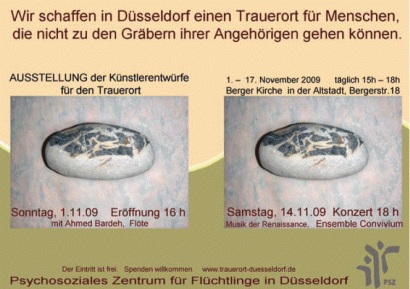
Ich nehme teil am offenen Wettbewerb zur künstlerischen Gestaltung eines multikulturellen Trauerortes im Außenbereich der Berger Kirche für das PSZ - psychosoziales Zentrum für Flüchtlinge Düsseldorf.
Das PSZ will für seine KlientInnen und für andere Zuwanderer einen "Trauerort" schaffen - einen Ort für diejenigen,die nicht zu den Gräbern ihrer Angehörigen gehen können.
Vom 1.11. bis 17.11.2009 (täglich 15 bis 18 Uhr ausser 4.11.) findet in der Berger Kirche,Berger Strasse 18,eine Ausstellung einer Auswahl der 52 eingereichten Entwürfe statt.
Anfang 2011 erschien eine Broschüre mit allen Entwürfen.
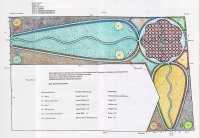
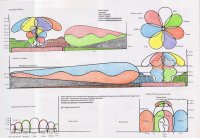
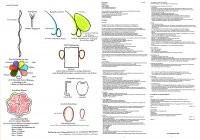
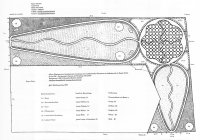
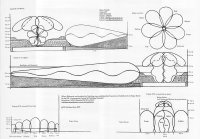
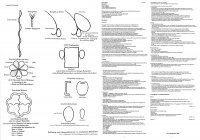
Open competition:
artistic design of a multicultural place of mourning (memorial) in the outskirt area of Berger Kirche (berger Church for the
PSZ - Psychosocial Centre for Refugees,Düsseldorf
7,Benrather Street
40213 Düsseldorf
Tel. +49 211 353 315
My layout:
A. Premise:
To begin with,I would like to say that I had not been given any clear details as to the base area (size etc.) at the start of my layout so that the outline of my design is rendered somewhat vaguely.
My layout allows for a few variations (regarding reduction of expenses and choise of material;in the text,see: (V)).
As one can see from my conception in part B.7,I decided on the most elaborate and intricate option which would also be the most expensive one (for corresponding alternatives,please,refer to the versions in brackets).
Part C (calculation of costs) shows the most cost-effective option.
As to the choise of material(s),the idea of recycling,in parts,already existing materials (small cobble stones;if applicable,the wood of the three trees on site) was an important component;not so much for reasons of cost but rather out of conceptual considerations (rooting/fastening/anchoring of the installation (with/) in Düsseldorfs Altstadt).
Basic concern of my layout: to transform this inhospitable place in to a poetic retreat by making use of the spatial guidelines:
- create a rite (of passage,so to speak) by way of a round tour i.e. alley (exit to Wallstraße)
- optimal use of the area and avoiding dead corners/blind angles
- clear and distinct views,lines,colours,propotions
- levelling the land area and then forming slightly rising and sloping grounds
- sight protection towards the north and Wallstraße (exit)
- removal of the three trees,thus reducing cultivation to hydrangeae
- (to a large extent) removing resp. (re)laying the cobble stones,levelling the ground
- incorporating the (constant) ventilation (from the adjoining site)
- with the help of a coloured shield/screen,turning the house wall in to a projection screen
- using many different natural materials (larger stones,cobble stones,pebbles,sand,lawn,tree slabs/wood) and reducing cultivation (the latter,amongst other reasons,against the current rat infestation).
Certain models for my design are:
The memorial in Laboe with its strongly recessed alleyway as well as,regarding the flowing water body,the memorial fountain for Lady Diana Spencer in Kensington Park,London.
B.Concept:
1.) Basic character:
Meditation,tranquillity,dignity,consecration,solemnity,beauty,poetry,strength,optimism = elegant,aesthetical arrangement,light colours and materials,bright,airy,uplifting,enchanting,friendly,tender and yet,as the same time protective,helpful,positive,supportive,consoling,peaceful,harmonious,paradisiacal (Heaven/Afterlife).
This is to be achieved through
- the basic construction being a round tour,or rather,an alleyway/passage way
- light movement (above all,through flowing water bodies and rotating shield)
2.) abstract/geometrical basic form: circle and oval
Associations:
Circle,cycle (Cosmos,among others (planets,stars);Earth (see 6 colours and white: the 7 continents);egg,Easter egg,fertility;fungus,tree,weeping willow;leaf/leaves (light absorpation,part of a whole);shield/screen;canopy;flower;petal;bird/feathers;butterfly (soul);
- abstract shapes (circles,ovals)
- near to nature materials: soil (earth),water,air,wood,stuff
- ground design,again,near to nature materials: stones,sand,grass/lawn,water,cultivation (hydrangeae)
- the element Air becoming visible through manouevred shield/screen (it being outside yet,at the same time,being an enclosed shelter i.e. protective space;transparency and lightness through both mobility and translucency of the materials)
- minimised use of certain designated colours and shapes and their recurrence/return
- motif: reflection of light (esp. floor towards (North- and East-)wall;shield to floor and to illuminated glass on the wall of the East house in the place of consecration) so to create a magical and definite coherence
3.) Ritual:
accomplished through a well-defined construction
- central place of consecration (with sacrificial altars incorporating all the four elements (Fire,Earth,Water and Air,marked with colours)
- both entrance and exit are gateways in to another,consecrated world and likewise,in their design,referring to the central shield
- easily conquerable yet clearly noticeable boundaries (as borderlines (from and) to the worldly everyday life) which can be overcome by crossing them (see bth entrance and exit gates at the place of consecration);entering the sanctuary through each gate,raised floor and altered floor condition (those being experienced physically)
- the door at the exit to Wallstraße can be opened from the inside without the help of a key but,when coming from Wallstraße,it requires a key;i.e. the passage way starts at Berger Straße
- natural floor condition (the path is to invite visitors to go barefoot)
- a fairly long,slightly rising and sloping path
- cycles: flowing water bodies,shield;i.e. slight movement
- usage of certain shapes and colours recurring
- only simple acts of the place of consecration i.e. the four sacrificial altars
- everything should be flexible/mobile for various different ceremonies/religions (personal/imagined/individual rituals possible);for example: utility space for devices used for sacrificial activities;belongings of the deceased/symbols for him/her
- if applicate,rotating (exit)gate and accompanying small (also rotating) shield
4.) the four elements:
- Air: shield/mobility,movement
- Water: flowing water bodies
- Earth: various different types of ground
- Fire: inclusion of natural light(ing) conditions and artificial lighting
5.) Design of the surrounding area:
- flowing water bodies which are meant to be crossed
- slight height (and level) differences/entrance in to another world
- alteration of the ground condition/walking barefoot through the gateway desired as an additional intensive sensual stimulus
- water well (right next to the sacrificial altar so to provide water) underneath the illuminated glass object in the sanctuary,the water coming from under fairly large white stones and feeding the slightly sloping streams
6.) workable/feasable (during sacrificial offerings):
- protected from the weather,any rain will run or drip from the edge of the shield directly in to the flowing water body underneath (association: teardrops from heaven feed the (eternal) font/source)
- no disturbances coming from outside (sight and noise protection)
- sence of space: shelter,strength and togetherness
- the large rotating shield may be fastened
- the water well underneath the illuminated glass object produces (alongside the artificial Ventilation) an airy meditative sound;the well may be switched off
7.) Material:
- the North wall will be plastered using white pebbles
- flowing water bodies will be built from stones (V: metal pipes)
- sight and noise protection through coloured synthetics (V: coloured,light,transparent (canvas) material)
- the three trees will be cut down;their wood will be used for both entrance and exit (gate) poles,for slabs in the sanctuary ground as well as for the seats;if necessary,the wood will also be used to make (parts of) the shield and the sight protection
- large shield made of coloured,light and transparent synthetics (V: coloured,light,transparent (sailcloth/) canvas);likewise made of synthetics would be the gates at the exit (V: coloured,light and transparent sailcloth/canvas material);thus,coloured light will illuminate both floor and walls
- central wall object on the wall of the East house in the sanctuary is a glass which appears colourful through the use of light voltage;this glass may be switched on and off,or rather,reacts to motion sensors at the entrance and,if applicable,also at the exit gate
8.) Proportions:
- entrance gate = exit gate = height of the North wall (210 cm)
- lawn area = (partly) oval (as long as the North wall but not as high)
- surface area of sanctuary = (size of) painting of the North wall
- sand area = oval on East wall
9.) any other references/relations:
- ovals: reference to the oval windows of the Berger Church
- circle: reference to the round red lamp in the Berger Church
- materials: cobble stones being a reference to Düsseldorf´s Altstadt and,if you like,to the bricks of the Berger Church
10.) Reflection/Mirroring:
the reflecting of shapes and colours,as a motif,creates a homogenous,independent,complete,magical and artificial area (with its culmination point in the sanctuary) and draws a clear and definite aesthetical dividing line between this area and the everyday world;this is achieved by way of
- the oval shape of the lawn being "mirrored" in the sight protection on the North side
- the surface area of the sanctuary being "mirrored" in the painting on the sanctuary´s North wall
- the shape of the shield being "mirrored" on the wall of the East house in(side) the illuminated glass object
- the oval shape of the sand area towards the exit being "mirrored" on the wall of the East house
11.) Colours
- colours symbolism: 7 colours representing the 7 continents of the Earth (the bereaved will be from all corners of the Earth);
White here stands out somewhat (see entrance and exit gate;white lamps in the front of the sanctuary,white glowing glass in the sanctuary,white pebbles,the white East house wall plus the mobile sacrificial implements);
White here is the "colour of mourning" or,to the more exact: White stands for the deceased
- no ornaments,no distraction,no decoration,only tranquillity,relaxation,ease,lightness,meditation,transcendence as well as (spatial) orientation through the odd pastel shades where the attribution regarding the four elements is as follows:
Water - light green
Air - light blue
Fire - light red
Earth - orange
- the artificial lighting (lamps) and the cultivation (hydrangea) incorporate this;added are yellow,light mauve and white
- the central large glass on the wall of the East house in the sanctuary takes in all colours as well as white (bottom);the (in parts white) sacrificial utensils (storage table,wooden seats) may be placed in front of the central glass;
this lighting glass is meant to lead,as it were,the visitor to the sanctuary (that is why the white hydrangea bushes to either side are not supposed to limit visibility)
12.) Movement:
- by way of water flowing bodies (for example in the sanctuary,clockwise)
- by way of the large rotating shield;variable handles: by way of enlarging & extending right up to small sail areas with their more intensive rotation due to the constant (artificial) ventilation anticlockwise;
the shield may be locked in position and thus,movement may be halted
13.) Light/Lighting:
- at 12 o´clock: incidence of light from the South/exit (due to the transparent shield,the North wall thus becoming the projection screen for the coloured light),and,after 6 o´clock p.m.,from the West (the large wall of the East house now being the projection screen)
- additional artifical lighting through lamps (also meant to be an aid for orientation in the twilight but,mainly for aesthetical and conceptual reasons)
- artificial lighting of the sanctuary,above all,through the illuminated glass object on the wall of the East house;variation: if applicable,additional light through lighting in the flowing water body (with LED lights)
C. Rough cost accounting (re. materials and work):
Material:
- cobble stones (using,partly,the already existing ones),larger stones (in the sanctuary),small white pebbles,sand,tree slabs/discs
- (light) glass in the sanctuary (including on/off switch i.e. motion sensor at the entrance and,if applicable,at the exit)
- 6 coloured (light) lamps
- coloured transparent canvasses/sail cloth and wooden poles for entrance and exit as well as sight protection and marquee/shield
- if necessary,metal pipes for flowing water bodies (rather than stones)
30.000 Euro
Labour costs:
- ground levelling
- arranging slight ground rising i.e. sloping
- flowing water bodies
- ground for sanctuary
- plastering North and East wall,in parts,with small white pebbles
- larger stones worked in to the four sacrificial sites in the sanctuary
10.000 Euro
Total 40.000 Euro
Further Information about the competition you find here: Trauerort

